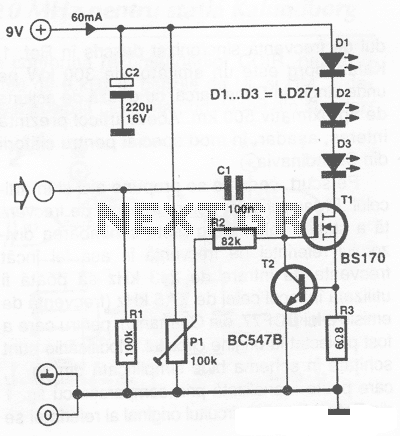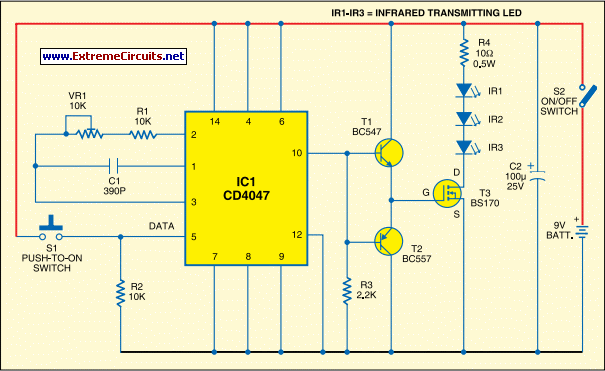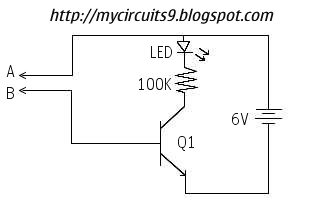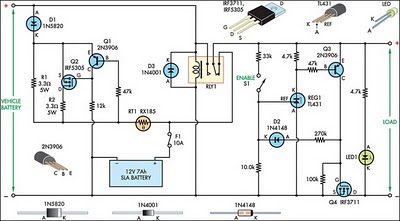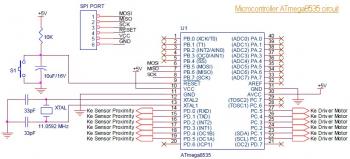
Variable-Sensitivity Phototransistor Circuit Circuit
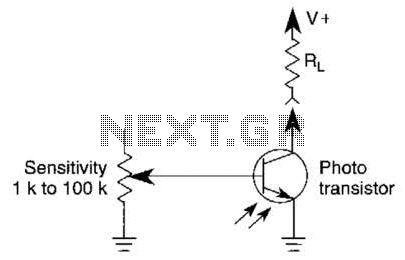
A variable resistor is utilized to adjust the light-level response of a phototransistor. Phototransistors exhibit higher light sensitivity compared to photodiodes; however, they typically demonstrate a lower frequency response.
A variable resistor, often referred to as a potentiometer or rheostat, plays a crucial role in controlling the sensitivity of a phototransistor in various applications. In circuits where light detection is essential, such as in light-sensitive switches or automatic lighting systems, the ability to fine-tune the response of the phototransistor to varying light levels is paramount. The variable resistor allows for adjustments in the current flowing through the phototransistor, thereby modifying its output based on the ambient light conditions.
Phototransistors are semiconductor devices that convert light into electrical current. They are particularly advantageous in applications requiring high sensitivity to light, making them suitable for use in environments with low light levels. However, the trade-off for this sensitivity is a reduced frequency response when compared to photodiodes. This means that while phototransistors can detect low levels of light effectively, they may not respond as quickly to rapid changes in light intensity.
In a typical circuit configuration, the phototransistor is connected in parallel with the variable resistor. The variable resistor's resistance can be adjusted, allowing for a range of light levels to be detected. This configuration provides flexibility in designing circuits that require specific light sensitivity thresholds. The overall performance of the circuit can be optimized by selecting the appropriate values for both the phototransistor and the variable resistor, ensuring that the system can respond adequately to the intended light conditions while maintaining the desired frequency characteristics.
In summary, the integration of a variable resistor with a phototransistor enhances the ability to tailor the light response of the circuit, balancing sensitivity and response time for effective light detection in various electronic applications. A variable resistor is used to vary the light-level response of a phototransistor. Phototransistors are more light sensitive than photodiodes, but they generally have poorer frequency response.
A variable resistor, often referred to as a potentiometer or rheostat, plays a crucial role in controlling the sensitivity of a phototransistor in various applications. In circuits where light detection is essential, such as in light-sensitive switches or automatic lighting systems, the ability to fine-tune the response of the phototransistor to varying light levels is paramount. The variable resistor allows for adjustments in the current flowing through the phototransistor, thereby modifying its output based on the ambient light conditions.
Phototransistors are semiconductor devices that convert light into electrical current. They are particularly advantageous in applications requiring high sensitivity to light, making them suitable for use in environments with low light levels. However, the trade-off for this sensitivity is a reduced frequency response when compared to photodiodes. This means that while phototransistors can detect low levels of light effectively, they may not respond as quickly to rapid changes in light intensity.
In a typical circuit configuration, the phototransistor is connected in parallel with the variable resistor. The variable resistor's resistance can be adjusted, allowing for a range of light levels to be detected. This configuration provides flexibility in designing circuits that require specific light sensitivity thresholds. The overall performance of the circuit can be optimized by selecting the appropriate values for both the phototransistor and the variable resistor, ensuring that the system can respond adequately to the intended light conditions while maintaining the desired frequency characteristics.
In summary, the integration of a variable resistor with a phototransistor enhances the ability to tailor the light response of the circuit, balancing sensitivity and response time for effective light detection in various electronic applications. A variable resistor is used to vary the light-level response of a phototransistor. Phototransistors are more light sensitive than photodiodes, but they generally have poorer frequency response.

